A city's wastewater treatment infrastructure is part of the groundwork of an entire community's organization and is one of a community's most costly endeavors. Using a centralized system often does not have environmental benefits since conclusive evidence shows that centralized sewer collection systems are leaking and causing treatment plant overflows during strong wet weather events. Leakage into streams and ground water commonly occurs in many places and is a significant problem in many communities across the United States.
A study in Albuquerque, N.M., concluded that leakage of wastewater from sewer pipes amounted to 10 percent of average daily wastewater flow at its treatment plant, or five million gallons per day. Due to cost and these types of overflow issues, alternative ways of providing wastewater service in suburban areas are gaining increasing attention.
In many situations, a decentralized/distributed system may be an option. Often seen as suitable only in low-density, rural situations and then only as temporary solutions, decentralized wastewater treatment systems are not usually thought of as an option for more than one home. However, with proper design, installation and operation, decentralized systems have many advantages. By collecting, treating, and reusing or disposing of wastewater from individual homes, buildings and/or cluster systems near the point of generation, decentralized/distributed systems can reduce the time, water amount and energy involved with treating wastewater with a higher pollutant removal rate.
Benefits for Developers
Developers who consider alternatives to sewer or center-collection systems actually see many reasons to choose decentralized/distributed systems for their homes. For example, a developer looking to build 50 suburban homes can have his project delayed up to five years while the city extends the existing sewer lines to the homes. Plus, the developer is likely going to pay significant sewer tap fees and substantial fees for the cost of extending sewer lines so current sewer customers will not see rate increases. If the developer is charged more, chances are the developer will charge the residents more. Additionally, especially in places like coastal areas, small lots and heavy regulation can tie the developer's hands if he is trying to put in a sewer. The five year or longer timeline is likely to stretch farther.
Because these decentralized/distributed systems are typically composed of modular, interconnected and easily replaceable parts, installation and maintenance is simple. It only takes a few days or weeks to install and start-up a decentralized system. The savvy developer does not have to plan as extensively in comparison to building a neighborhood with a sewer. The developer may also decide to use these systems instead of building out from the central infrastructure because they require less time and money to obtain permits. One of the major benefits of these systems is the developer can build out slowly and add to the treatment system as needed to maintain treatment, so the initial costs are significantly lower.
As an example, small, quick-to-install, wastewater treatment units are available. Modular units can typically treat 500 gallons per day or significantly more using a cluster system treating from 3,000 up to 160,000-plus gallons/day-enough to accommodate an entire community. Fixed activated sludge treatment units are easily upgradable, scalable and fill considerably less space than centralized treatment options. Moreover, these advanced treatment systems offer a water reuse opportunity for community parks, schools, golf courses and other common areas. The developer also has more options in terms of the topography and/or type of land available, which not only increases property value but can lead to a decrease in urban sprawl.
Benefits for Residents
Homeowners generally do not like to think about sewage treatment. Frequently, residents who live near a large treatment plant will be irritated by its smell, noise or appearance. Residents will be happy to know that odor is usually less of a concern with decentralized/distributed systems, and they are typically almost unseen because they can be installed below ground.
Since the size of land normally reserved for the drain field on a given property can be reduced by using individual onsite systems or eliminated by using cluster systems, the residual land can be used for other structures like a pool or common areas like parks or green space. Another benefit is that the treated water can be reused for drip tube irrigation of the lawn or other landscaped areas.
Whenever a community has a centralized wastewater system and developments are proposed, questions are likely to arise over how the costs and benefits of the system are to be distributed, which can be avoided when all the costs and benefits go to single homes or clustered developments. It is also important to consider that property values near large centralized systems understandably decrease. Houses with individual or distributed systems have a more equal distribution of value. In addition, distributed/decentralized systems are often much more economical for smaller communities than sewers. In 1995, for instance, Columbus, N.M., had a choice between paying $4.21 million for sewers with aerated wetlands and ponds, or paying $1.19 million for new single home treatment systems.
Septic Systems Have Had a Negative Reputation
Frequent system failures are associated with the various types of conventional septic systems. When developers contract with a company or individual to install onsite systems, they are looking to minimize costs by adhering to the minimum standards instead of looking to protect the environment. Sometimes they are simply unaware that other options exist. Usually, the failures are characterized by unpleasant events affecting an entire development of homes where the systems were not designed or installed properly. Events include untreated wastewater surfacing on the ground or backing up into the houses. Many assume that onsite systems simply cannot be reliable. However, looking deeper into the situation, the problems of onsite systems diminish considerably when a system using proven technology is designed, installed and maintained correctly, and given no harsh chemicals to treat.
Homeowners can help take care of the system and extend its life. Reading the owner's manual of any treatment system is a must. In it, homeowners are reminded that paint thinners, medicines and even liquid fabric softeners can be harmful to a septic system. Regular inspection and pump out of septic tanks also goes a long way in reducing failures. A professional should always perform any maintenance to a system. The good news is that decentralized systems require less operation and maintenance than centralized wastewater treatment plants, and therefore can be less costly to maintain overall.
Environmentally Conscious
Properly designed, installed and operated decentralized/distributed wastewater systems have significantly cleaner effluent than centralized systems. Untreated water is sometimes disposed to the environment with centralized systems due to aging infrastructure, water main breaks, flooding or poor operation. Often, minimal energy is needed to create this superior effluent. Using again the example of a modular unit, the blower can be cycled on and off for two reasons: reduced operating cost (up to 45 percent) and improved nitrogen reduction performance (in specific situations).
A great concern of the EPA is the amount of nitrates a system releases into the environment. These nitrates can enter groundwater and under the right conditions are implicit in causing certain birth defects and are thought to cause other disorders like hyperthyroidism. If too many nitrates enter a pond or lake, they create algae, which destroy oxygen in the water and subsequently kill fish. Many centralized systems remove hardly any nitrates, while some distributed/decentralized systems remove an impressive amount of nitrates.
Water table levels and stream base flows can be harmed by the use of centralized systems and are improved or preserved by the use of decentralized/distributed systems. Centralized systems do not discharge effluent anywhere near where homes or businesses use and/or obtain water. Many streams lose water to these systems, but with decentralized systems, the water goes to the nearby leach field and possibly back into the stream. In addition, riparian zones (the area between land and a stream) are less frequently disturbed by the installation and operation of onsite systems than they are by sewer systems.
Conclusion
It is important for developers and residents to decide what type of wastewater system is most feasible to implement-economically, politically and environmentally. It is not always a clear choice, but substantial evidence shows decentralized systems are frequently a solution. They are less labor intensive for responsible builders and homeowners, and they are a more environmentally friendly.
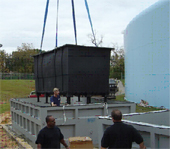
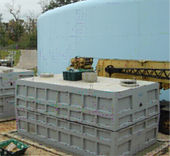
Temporary community system in Louisiana


Community units with drainfield in Virginia
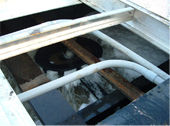
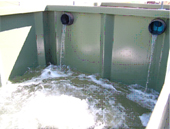
Commercial unit in steel tank in Mexico
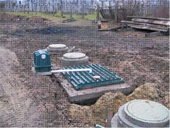
Residential system in Lativa
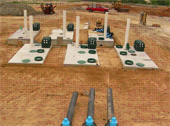
Multiple units to accomodate a large project

